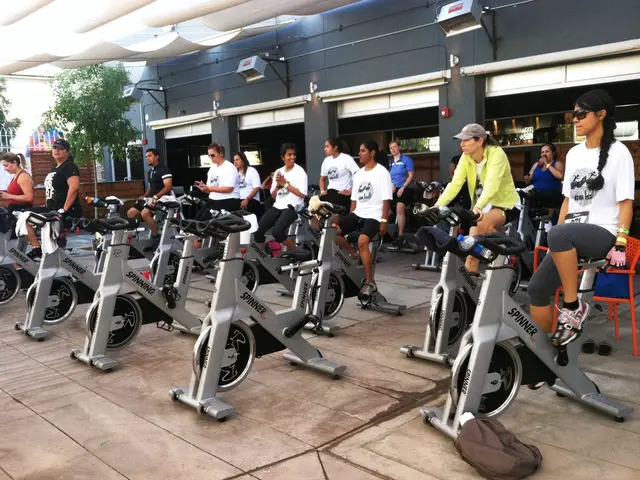Physical therapy expert points out potential link between a specific muscle's weakness, persistent knee and back aches, and offers a straightforward diagnostic method.
Nope, it's a common misconception that knee pain is solely due to weak knee joints. Often, the real issue stems from a weak muscle somewhere else in the body. According to physical therapist Tom Williams at Activ8rehab, the likely suspect might be your gluteus medius, one of the three muscles in your glutes, located on the outside of your pelvis.
Even active individuals can show signs of weakness in this muscle, which may contribute to pain in other areas like your back or even increasing the risk of injury.
So, how do you tell if your glute medius needs some attention? Williams suggests a simple test: the side plank leg lift. Give it a try:
The gluteus medius strength test
The test: Side plank leg lift
- Lie on your side, resting your forearm on the ground with your elbow beneath your shoulder.
- Engage your core and lift your hips so your body forms a straight line.
- Lift your top leg, pause, then lower with control.
If your hips drop as you lift your top leg, or you struggle to lift your leg without twisting or wobbling, it's a sign that your gluteus medius needs some strengthening.
Why does the gluteus medius matter?
According to Williams, the gluteus medius helps in stabilizing your movements, especially when walking and running. When this muscle is weak, it doesn't do its job properly, and other muscles end up taking on the additional load. For instance, the tensor fascia lata (TSL) at the front of your hips and the iliotibial band (ITB).
This can result in issues like runner's knee or ITB syndrome due to the constant compression on your knee caused by the repeated load on every stride while running.
In a nutshell, the gluteus medius supports your movement and helps stabilize the pelvis. But if it's too weak, it will overload other muscles, leading to potential pain or injury in your knees, hips, and even lower back.
Personal Experience
When I previously sought help for chronic knee pain, a physical therapist quickly identified weakness in my gluteus medius. The side plank leg lift Williams recommends was one of the exercises I was prescribed. At first, I needed to modify the side plank position with my lower leg's knee touching the floor. But, with time, I progressed to doing the leg lift from a full side plank.
After consistently doing this exercise two to four times a week for the past two years, my knee pain has decreased significantly, boosting my confidence in running and walking. Even today, I still include this move in my workout routine because it offers benefits beyond just building strength—it improves stability, balance, core control, and coordination.
Exercises to strengthen your gluteus medius
Williams advises focusing on exercises that resist external hip rotation to challenge and strengthen your gluteus medius. Here are three exercises that can help you develop the needed strength:
- Clamshell: Lie on your side with bent hips and knees, your feet stacked on top of each other. Lift your top knee as high as possible while keeping your pelvis still. Lower your knee slowly, and repeat. Use a resistance band around your knees for extra challenge.
- Banded side step: Stand with a resistance band placed just above your knees and feet wider than hip-width apart. Take a small step to the right with your right foot and follow with your left foot, maintaining tension in the band. Repeat in the opposite direction.
- Side plank with leg lift: Adopt a plank position on your side, propped up on your forearm. Lift your top leg with your foot bent, pause, then lower with control. Do your reps on one side, then switch sides.
Strengthening the gluteus medius is crucial for maintaining hip stability, essential for activities like running and preventing knee pain. So, give these exercises a try and say goodbye to knee misery!
[1] - Prentice, W. (2016). The Gluteus Medius in Running. Retrieved January 10, 2023, from https://www.ncbi.nlm.nih.gov/pmc/articles/PMC4741539/
[2] - Anatomy Trains: Myofascial Meridians for Manual and Movement Therapists. (2016). Upper body anatomy. Retrieved January 10, 2023, from https://www.kimcom.co/ATMB/text/pdf/ATMB_chapter3.pdf
[3] - Foster, N., & Huck, A. (2019). The Gluteal Muscles and Common Training Errors. Retrieved January 10, 2023, from https://www.ncbi.nlm.nih.gov/pmc/articles/PMC6733435/
[4] - Krych, A. J. (2015). Hip Strengthening in the Treatment of Runner's Knee. Retrieved January 10, 2023, from https://www.ncbi.nlm.nih.gov/pmc/articles/PMC4881307/
Engaging in workouts that focus on resistance exercises and core stabilization, as suggested by physical therapists, can help strengthen the gluteus medius and improve overall fitness-and-exercise routine. Strengthening this muscle can also lead to better health-and-wellness outcomes, such as preventing runner's knee and other potential knee, hip, or lower back injuries that may result from its weakness.







